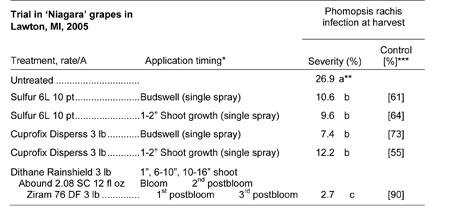There is still time for a delayed “dormant” spray against Phomopsis in grapes
Editor’s note: This article is from the archives of the MSU Crop Advisory Team
Alerts. Check the label of any pesticide referenced to ensure your use is
included.
There
is still time for delayed dormant sprays in grapes though the vines are
technically no longer dormant. The goal of the dormant spray is to kill
fungal pathogens that overwinter in the woody parts of the vine. While
it is not possible to kill all of the fungus inoculum, it is possible to
make a dent in spore-production, reducing disease pressure during the
growing season. In most years we have seen a benefit from dormant
sprays, but the degree has varied (from 10-70 percent). Results tended
to be better during relatively dry springs than very wet springs. An
early mancozob spray (1-2 inch shoot growth) may also work to kill
fungus inoculum in addition to protecting new growth.
In 2005, we tested whether applying “dormant” sprays at 1-2 inches of shoot growth was still effective at reducing Phomopsis in ‘Niagara’ grapes (Table 1). The difference in spray timing was only 11 days that year, however. A reduction in rachis infection at harvest was seen for both Sulfur 6L and Cuprofix. While Cuprofix at 1-2” shoot appeared somewhat less effective, the differences were not statistically different, which means that they could have been due to natural variation in the vineyard. The season-long fungicide spray program was the most effective at reducing Phomopsis at harvest.

*Budswell spray: April 14, 2005; 1-2 inch shoot spray: April 25, 2005
**Values in the same column that share a letter are not significantly different from each other at the 95% confidence level.
***Percent control relative to the untreated check.
We did not see any phytotoxicity as a result of the treatments in ‘Niagara’ grapes, even when applied at 1-2 inch shoot growth. ‘Niagara’ and ‘Concord’ are only slightly copper sensitive. The risk of copper phytotoxicity to green leaves is greater under cool, wet, slow-drying conditions, which allow copper ions to be absorbed by the leaves. Concord is sulfur sensitive, but sulfur phytotoxicity is much more likely at temperatures above 85-90ºF, which are unusual at this time of the year.
To get the maximum benefit out of dormant sprays, it is important to ensure thorough coverage of the canes by focusing nozzles of spray equipment only on the cordon, lowering air intake, slowing down and spraying at a sufficiently low volume (e.g., 20-30 gpa) that allows good coverage of the canes but no run-off. This ensures that the product is not diluted too much. Spraying every row is advised.
Dormant sprays should not be used as a stand-alone disease control measure. One or two mancozeb or captan sprays around mid-May when Phomopsis is expected to be most active may be beneficial. A strobilurin fungicide, such as Abound, Pristine or Sovran, applied at bloom or first post-bloom is also recommended to provide additional protection of the clusters against Phomopsis as well as black rot, powdery mildew and downy mildew. Phosphorous acid fungicides also have good efficacy against Phomopsis and can be used throughout the growing season, either alone or in combination with other fungicides (do not tank-mix with copper).



 Print
Print Email
Email


